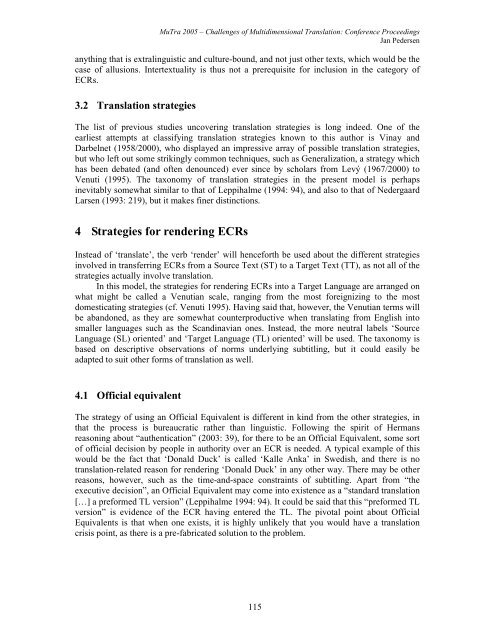Proceedings - Translation Concepts
Proceedings - Translation Concepts
Proceedings - Translation Concepts
You also want an ePaper? Increase the reach of your titles
YUMPU automatically turns print PDFs into web optimized ePapers that Google loves.
MuTra 2005 – Challenges of Multidimensional <strong>Translation</strong>: Conference <strong>Proceedings</strong><br />
Jan Pedersen<br />
anything that is extralinguistic and culture-bound, and not just other texts, which would be the<br />
case of allusions. Intertextuality is thus not a prerequisite for inclusion in the category of<br />
ECRs.<br />
3.2 <strong>Translation</strong> strategies<br />
The list of previous studies uncovering translation strategies is long indeed. One of the<br />
earliest attempts at classifying translation strategies known to this author is Vinay and<br />
Darbelnet (1958/2000), who displayed an impressive array of possible translation strategies,<br />
but who left out some strikingly common techniques, such as Generalization, a strategy which<br />
has been debated (and often denounced) ever since by scholars from Levý (1967/2000) to<br />
Venuti (1995). The taxonomy of translation strategies in the present model is perhaps<br />
inevitably somewhat similar to that of Leppihalme (1994: 94), and also to that of Nedergaard<br />
Larsen (1993: 219), but it makes finer distinctions.<br />
4 Strategies for rendering ECRs<br />
Instead of ‘translate’, the verb ‘render’ will henceforth be used about the different strategies<br />
involved in transferring ECRs from a Source Text (ST) to a Target Text (TT), as not all of the<br />
strategies actually involve translation.<br />
In this model, the strategies for rendering ECRs into a Target Language are arranged on<br />
what might be called a Venutian scale, ranging from the most foreignizing to the most<br />
domesticating strategies (cf. Venuti 1995). Having said that, however, the Venutian terms will<br />
be abandoned, as they are somewhat counterproductive when translating from English into<br />
smaller languages such as the Scandinavian ones. Instead, the more neutral labels ‘Source<br />
Language (SL) oriented’ and ‘Target Language (TL) oriented’ will be used. The taxonomy is<br />
based on descriptive observations of norms underlying subtitling, but it could easily be<br />
adapted to suit other forms of translation as well.<br />
4.1 Official equivalent<br />
The strategy of using an Official Equivalent is different in kind from the other strategies, in<br />
that the process is bureaucratic rather than linguistic. Following the spirit of Hermans<br />
reasoning about “authentication” (2003: 39), for there to be an Official Equivalent, some sort<br />
of official decision by people in authority over an ECR is needed. A typical example of this<br />
would be the fact that ‘Donald Duck’ is called ‘Kalle Anka’ in Swedish, and there is no<br />
translation-related reason for rendering ‘Donald Duck’ in any other way. There may be other<br />
reasons, however, such as the time-and-space constraints of subtitling. Apart from “the<br />
executive decision”, an Official Equivalent may come into existence as a “standard translation<br />
[…] a preformed TL version” (Leppihalme 1994: 94). It could be said that this “preformed TL<br />
version” is evidence of the ECR having entered the TL. The pivotal point about Official<br />
Equivalents is that when one exists, it is highly unlikely that you would have a translation<br />
crisis point, as there is a pre-fabricated solution to the problem.<br />
115
















